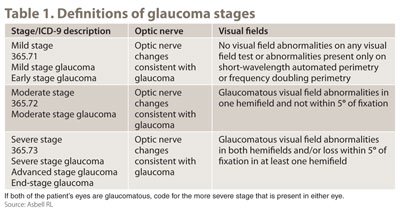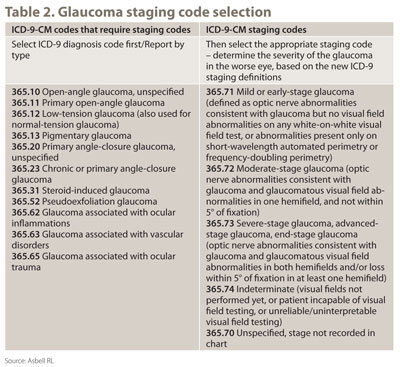Revised coding methodology for glaucoma available
The system involves grading the severity of glaucoma based on optic nerve findings and/or visual field abnormalities.
 Riva Lee Asbell |
A new diagnosis coding methodology has been developed, effective Oct. 1, 2011, that enables more detailed and specific glaucoma diagnosis coding for those who have the need to track such data. It will be carried over to ICD-10 effective Oct. 1, 2013; however, the codes themselves will obviously be changed.
The new system grades the severity of glaucoma for coding purposes based on optic nerve findings and/or visual field abnormalities. The system was a collaborative effort between the American Academy of Ophthalmology and the American Glaucoma Society.
Table 1 outlines the definitions of glaucoma severity.
Table 2 presents a correlation with instructions on how to use the new staging codes. The ICD-9-CM codes are in the left column, and the new additive staging codes are in the right column.
 |
 |
Glaucoma suspects and risk factors
Revisions to the codes for glaucoma suspects have been made more granular by introducing the concept of risk factors to the equation.
Open-angle glaucoma suspects (based on the number of risk factors: family history, race, elevated IOP, optic disc appearance and thin central corneal thickness):
365.01 Open-angle suspect, low risk (one or two risk factors)
365.05 Open-angle suspect, high risk (three or more risk factors)
Angle-closure borderline/suspects:
365.02 Primary angle-closure suspect (anatomical suspect, narrow angle)
365.06 Primary angle-closure without glaucoma damage (defined as angle damage such as peripheral anterior synechiae or high IOP, but without optic nerve damage)
Primary angle-closure glaucoma:
365.23 Chronic angle-closure glaucoma (angle damage plus optic nerve damage)
Tips
Here are some tips to help you:
- Use of the staging codes is not mandatory at this time; however, it is recommended you begin using them.
- All glaucoma diagnoses present in ICD-9-CM are not included in the list, nor is it necessary to pair them with a staging code.
- If each eye is at a different stage, then code the most severe stage.
- As the severity changes, thus you will be changing the staging code as the disease progresses.
- Glaucoma suspects would not be coded using staging codes.
- The staging codes cannot be used independently.
- The codes are used each time a claim is submitted, in much the same way diabetes mellitus is coded followed by diabetic retinopathy.
- Reimbursement is not affected at this time by use or nonuse; however, this probably will change as time goes on.
- If your Medicare Administrative Contractor has added the staging codes to the LCD for diagnostic tests such as visual fields and scanning computerized ophthalmic diagnostic imaging, you may use those codes for diagnostic testing as well as office visits.
Check your 2012 ICD-9-CM for a definitive review of all the codes.
References:
- Fellman RL, Mattox CG, et al. Know the new glaucoma staging codes. Eyenet. October 2011.
- Hasson M. New Medicare diagnosis codes apply to stages of glaucoma severity. Ocular Surgery News. 2011;29(14):22.
- Savvy Coder article. Eyenet. http://www.aao.org/aao/publications/eyenet/201110/coder.cfm. October 2011.
- Stein JD, Kim DS, Mattox C, et al. Glaucoma staging codes teaching module. American Glaucoma Society. http://www.surveymonkey.com/s/FVV2G75.
For your information:
- Riva Lee Asbell is president of Riva Lee Asbell Associates, an ophthalmic reimbursement consulting firm, and a clinical assistant professor of surgery (ophthalmology) at the University of Medicine and Dentistry of New Jersey/Robert Wood Johnson Medical School at Camden. She can be reached at RivaLee@aol.com; website: www.RivaLeeAsbell.com.
